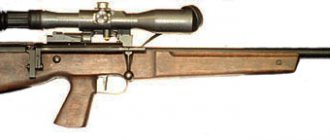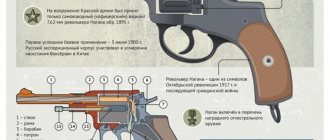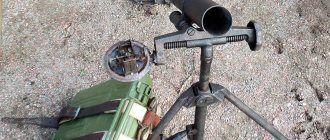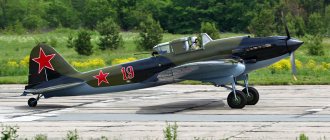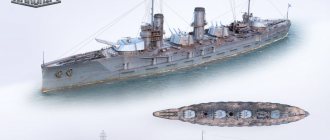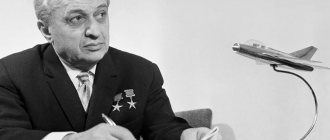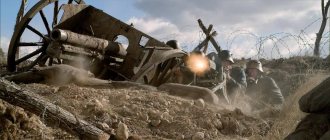Designer Leonid Kurchevsky: life and fate (1890−1937)
Natalya Samover, Elena Anikst, Mikhail Anikst “Trinity Option” No. 21 (265), October 23, 2022
Kurchevsky in the garden near his house on 1st Invalidnaya Street. Early 1930s
From September 11 to October 14, 2018, an exhibition dedicated to the talented Russian designer Leonid Kurchevsky
, whose creative activity was interrupted by arrest and execution in November 1937.
We thank the organizer and compiler of the exhibition, Natalya Samover,
for the materials presented.
The exhibition project was prepared by Elena
and
Mikhail Anikst
.
The career rise and incredible creative activity of Leonid Kurchevsky became possible thanks to the strong support of the chief of armaments of the Red Army, Deputy People's Commissar of Defense M. N. Tukhachevsky, who showed particular interest in innovative ideas and developments in the military field. In particular, in those same years, on his instructions, the Jet Research Institute was created, the deputy director of which was S.P. Korolev, the future general designer of space rockets. According to his ideas about the maneuverable war of the future, Tukhachevsky planned the rearmament of Soviet artillery and, in particular, the widespread introduction of recoilless rifles.
Kurchevsky's recoilless dynamo-reactive guns (DRP) - light and powerful - were considered the most promising direction in the development of artillery. Several dozen types of DRP were created - aviation, naval, for field, self-propelled and mountain artillery. Aircraft designers D. P. Grigorovich, S. A. Lavochkin and A. N. Tupolev designed aircraft specially adapted to be armed with such weapons. In 1931–1935, Kurchevsky guns accounted for 30 to 50% of orders from all artillery factories in the country. The testing of military equipment by the Kurchevsky Design Bureau was often attended by the country's leaders, including Stalin, who personally favored the designer and even gave him a car.
He taught his wife to drive a car, a glider, a snowmobile, an airplane—everything that he could fly himself, and Maria Fedorovna accompanied him everywhere. Very often they were joined by friends of his youth, Sergei Yudin (a famous surgeon) and Boris Stechkin (an outstanding aircraft engine designer).
Having gone through arrest and imprisonment himself, Kurchevsky fearlessly supported his friends. According to the memoirs of M. F. Kurchevskaya, when in the fall of 1930 Stechkin was arrested and convicted as part of the Industrial Party case, he helped his family in every possible way: he transported their things in his car, supplied them with food and kerosene, and to those of his acquaintances who then turned away from the Stechkins , Kurchevsky did not shake hands. A year later, thanks to the petition of Academician S.A. Chaplygin, Stechkin was released early and became one of Kurchevsky’s permanent collaborators and co-authors. The second time he will be arrested and end up in the “sharashka” after Kurchevsky’s death. Later, B.S. Stechkin, in turn, will help his friend’s wife who survived the repression.
Kurchevsky in a car with DRP. 1930
The first half of the 1930s became Leonid Kurchevsky's finest hour. Dozens of research institutes and design bureaus, many factories, training grounds and military units, and thousands of people were involved in the orbit of his work. Over the years, under his leadership, several dozen types of DRP with calibers from 37 to 420 mm were developed, including the 76-mm battalion gun (BPK), a mining pack gun, a light mortar for infantry, a self-propelled gun SU-4, an aviation dynamo-reactive gun APK, rocket anti-tank gun, etc.
Prototypes of Kurchevsky guns were installed on automobile and tractor chassis, on motorcycles and light tanks, on airplanes, torpedo boats and destroyers. However, Kurchevsky’s ideas were several decades ahead of their time and could not be adequately implemented under existing conditions. Soon the designer had to pay for this. As the Honored Inventor of the RSFSR S.D. Bogoslovsky, design engineer and friend of L.V. Kurchevsky, noted, “ the crown of his creativity, which was ten years ahead of its time, was the guns he designed. We are talking about guns that worked on the reactive principle."
.
“Kurchevsky’s character was formed in his passion for new, often daring ideas, in the desire to implement them by any means. Not a moment of stagnation or calm. Complete disregard for clothing and appearance, living conditions, money and well-being. His knowledge, mental acuity and sensitivity amazed the scientists and inventors with whom he worked...
»
Everything ended in 1937. On February 17, the People's Commissar of Heavy Industry of the USSR G. M. Ordzhonikidze committed suicide, apparently unable to withstand the atmosphere of suspicion and political persecution that was thickening in the country and around him personally. On May 11, Marshal of the Soviet Union Tukhachevsky was removed from the post of Deputy People's Commissar of Defense of the USSR. On May 22, he was arrested on charges of treason, participation in the activities of a “military-Trotskyist organization,” conspiracy to seize power in the country and deliberately undermining the defense capability of the USSR, which was expressed in the fact that he slowed down the development of certain weapons systems and encouraged developments of others, which in fact “turned out to be ineffective.”
On June 11, the Special Presence of the Supreme Court of the USSR at a closed court hearing examined the case of conspiracy in the Red Army and found all the defendants guilty and sentenced them to capital punishment. On the night of June 12, 1937, Tukhachevsky and military leaders I. E. Yakir, I. P. Uborevich, A. I. Kork, R. P. Eideman, B. M. Feldman, V. M. Primakov, who were involved in the same case , V.K. Putna were shot in Moscow. Their bodies were burned in the crematorium of the Donskoye Cemetery in Moscow, and the ashes were buried in a common grave. Leonid Kurchevsky had less than six months to live...
Chronicle of life
1890, September 22: L. V. Kurchevsky was born in Pereslavl-Zalessky.
Father - Vasily Grigorievich Kurchevsky - artist, photographer, art teacher; mother - Maria Nikitichna Polyakova. 1902, August: Leonid Kurchevsky enters the famous 2nd Moscow Gymnasium. Class teacher - N.V. Kashin. Lenya is his favorite student. He studies in the same class with Seryozha Yudin, a future famous surgeon.1905: Revolutionary events made a great impression on Lenya and Seryozha. Friends try to cause an explosion in the gymnasium, but fortunately the charge turns out to be weak. After the destruction of the Moscow merchant’s greenhouse by young “revolutionaries”, Lenya is temporarily expelled from the gymnasium.
1911: After graduating from high school in Moscow, he enters the Faculty of Physics and Mathematics of Moscow University.
1913: Forced to leave university studies because his family could not pay for his education.
1917: Serves in the design bureau of the Moscow Military-Industrial Committee. Makes his first invention - a machine for throwing grenades.
1918: Meeting his future wife Maria Fedorovna Kostina.
1920: Kurchevsky is actively engaged in design and inventive activities, restores old cars, designs an engine capable of running on a mixture of alcohol and ether in conditions of gasoline shortages, creates prototypes of an air car with a propeller, the calculations of which were carried out by V. P. Vetchinkin.
1922: Marriage to Maria Kostina. He heads the workshop-autolaboratory under the Committee for Inventions at the Scientific and Technical Department of the Supreme Council of National Economy. Designs an air car. Developed a special emulsion for instant “healing” of damaged car tires.
1923: Together with S. D. Bogoslovsky, he creates a jet planing torpedo, sliding at high speed along the surface of the water. At the same time, together with engineer S.A. Izenbek, he successfully tests and submits an application for the invention of a recoilless weapon - a dynamo-reactive gun (DRP).
The country's top military leadership decided to begin work on the creation of a regimental DRP and an automatic aircraft DRP.
1923, September 23: Arrested along with a group of auto laboratory employees on charges of embezzlement of public funds for unauthorized construction of a helicopter.
1924, March 2: By resolution of the Collegium of the Prosecutor General of the OGPU, L.V. Kurchevsky was convicted under Art. 108, 110, 113, 188 of the Criminal Code of the RSFSR to 10 years in prison. To serve his sentence, he was sent to the Solovetsky Special Purpose Camp (SLON). Over the next five years, he is actively working on restoring the economy of the Solovetsky Islands and creating the transport and energy infrastructure of the camp. He is allowed to move freely around the camp and even own a gun and hunt.
Kurchevsky and his employees in the glider he built. 1926
In winter, the Solovetsky Islands were inaccessible, and Kurchevsky, who arrived with a group of convicts, was in prison in Kem before the opening of navigation. But as soon as he found himself on Solovki, he immediately showed his vigorous energy, organizational and design talents. The monastery was destroyed by a recent catastrophic fire, the entire economy of the islands was in decline, but Kurchevsky quickly established the work of the forge, restored the small power plant that previously existed on the island, and under his leadership the narrow-gauge railway was reconstructed, connecting the production points of the camp; Steam locomotives appeared on Solovki already in 1924. The shipyard began operating, where, according to Kurchevsky’s instructions, motor boats were built, adapted for sailing among the icy slush. The snowmobile and light glider with a propeller he built made it possible to establish year-round communication between the islands and the mainland.
1926 - early 1927: Builds a working model of his dynamo-reactive gun (DRP) in camp workshops.
1929, January 3: By resolution of the OGPU Collegium, he was released early.
1930, January: L.V. Kurchevsky was appointed chief designer of OKB-1 of the Main Artillery Board of the RKK.
1933: Awarded the Order of the Red Star.
1934: Heads a specially created structure - the Office of the Commissioner for Special Works (UUSR) under the People's Commissariat of Heavy Industry, which is developing a whole range of weapons from aviation to small arms, but the focus is still on dynamo-reactive guns.
1936, February: The Ukrainian Ukrainian Socialist Republic is liquidated after inspections by the Main Directorate of the Aviation Industry and the Party Control Commission under the Central Committee of the All-Union Communist Party of Bolsheviks. The aircraft guns created by Kurchevsky were recognized as unfinished, followed by other weapons of his design. Nevertheless, he continues to work with a small design team.
1937, June 15: L.V. Kurchevsky was arrested on charges of sabotage, allegedly on the instructions of the exposed “enemy of the people” Tukhachevsky.
November 25: The Military Collegium of the Supreme Court of the USSR sentenced him to capital punishment.
November 26: The sentence is carried out.
1937, July 17: Arrest of Maria Fedorovna Kurchevskaya.
December 28: M. F. Kurchevskaya was sentenced to eight years in labor camp. Released on March 23, 1944.
1956, February 18: The Military Collegium of the USSR Armed Forces decides: the verdict of November 25, 1937 against L.V. Kurchevsky “due to newly discovered circumstances” is canceled, the case is terminated for lack of corpus delicti. Designer L.V. Kurchevsky was posthumously rehabilitated.
Memories of colleagues
«If at the beginning of the Great Patriotic War this system had been in service with the Soviet Army, now we can assume that it could have successfully resisted and destroyed the German motorcyclists operating in the vanguard, armed only with machine guns. Perhaps these light, highly maneuverable Kurchevsky recoilless guns could to some extent influence the initial phase of the Great Patriotic War
"(V. Dorina, Kurchevsky's employee).
“All his proposals invariably shone with originality, boldness of technical thought and were distinguished by the simplicity of their constructive solution. All of Kurchevsky’s works and all of his inventive work were aimed at strengthening the power of our Motherland.”
(K.K. Glukharev - designer of artillery systems).
“Those who knew him repeat almost word for word that he was instantly infuriated, infuriated by complaints about human weaknesses, all these usual “tired”, “difficult”, “where can I get it?”, “not it turns out"
...
Apparently, he really knew, was able to and still accomplished much more than anyone else”
(I. E. Chutko, journalist, researcher of the history of Russian science and technology).
(by country)
Countries
| Great Britain |
| Germany |
| Denmark |
| Poland |
| Russia/USSR |
| Finland |
| Czechoslovakia |
| Switzerland |
| Sweden |
| Japan |
Countries
| Great Britain |
| Germany |
| Denmark |
| Poland |
| Russia/USSR |
| Finland |
| Czechoslovakia |
| Switzerland |
| Sweden |
| Japan |
Anti-tank rifle Kurchevsky "K"
The first Soviet serial anti-tank gun was the 37-mm dynamo-reactive gun PTR "K", which was designed by the Soviet inventor Leonid Vasilyevich Kurchevsky (1891-1937).
- Weapons » Anti-tank rifles » Russia / USSR
- 2691
More details
Anti-tank rifle Panzerbüchse PzB 40 M / Model 41
The Model 41 anti-tank rifle, designated “PzB 40 M,” was created by designers in Oberndorf am Neckar. The gun's automation worked on the principle of removing powder gases from the barrel.
- Weapons » Anti-tank rifles » Germany
- 3661
More details
Anti-tank rifle W/15
In 1940-1941, Czech gunsmiths and German specialists from the SS-Waffenakademie weapons academy developed the W/15 anti-tank rifle, designed to use the Czech 15x104 machine gun cartridge.
- Weapons » Anti-tank rifles » Czechoslovakia
- 3665
More details
Anti-tank rifle W/7.92
In 1940-1941, Czech gunsmiths and German specialists from the SS Weapons Academy "SS-Waffenakademie" in Brno, to combat tanks and other armored targets, as well as to fire at the embrasures of long-term fire installations, developed a 7.92-mm magazine-fed anti-tank rifle " W/7.92".
- Weapons » Anti-tank rifles » Czechoslovakia
- 3666
More details
Anti-tank rifle Panzerbüchse PzB 40 K / Model 43
The Model 43 anti-tank rifle, which a little later received the index “PzB 40 K,” was created by designers from Suhl. At the same time, they developed seven samples of this model, differing from each other in details.
- Weapons » Anti-tank rifles » Germany
- 3687
More details
Anti-tank rifle BSW Model 1
BSW presented a prototype of a single-shot 15-mm anti-tank rifle, designated “BSW Model 1”, which was an enlarged version of the PzB 38 PTR, but designed for a 15 mm caliber.
- Weapons » Anti-tank rifles » Germany
- 3877
More details
Anti-tank rifle Panzerbüchse PzB 40 G / Model 42 / Model 44
In 1940, the Gustloff-Werke concern presented two samples of self-loading anti-tank rifles - Model 42, which received the index "PzB 40 G" and Model 44. The weapon's automation worked on the principle of removing powder gases from the barrel.
- Weapons » Anti-tank rifles » Germany
- 3923
More details
Anti-tank rifle Panzerbüchse PzB 42
In 1940-1941, specialists from the SS-Waffenakademie and Waffenwerke Brunn developed a large-caliber anti-tank rifle. According to some information, this gun was never mass-produced. According to others, a small batch was delivered to Italy. According to the third, it was in small quantities in service with the Waffen SS under the designation PzB 42.
- Weapons » Anti-tank rifles » Germany
- 3926
More details
Anti-tank rifle Gustloff-Werke Model 1941
In the fall of 1941, the designers of the Gustloff-Werke company, as part of the Panzerbüchse 243 program, introduced a 15-mm self-loading anti-tank rifle, which received the Model 1941 index.
- Weapons » Anti-tank rifles » Germany
- 3981
More details
Anti-tank rifle Kb ppanc wz.35 / Kb Ur wz.35 / Karabin Maroszka
During military tests in November 1935, the Marozhka anti-tank missile system showed more than its best performance, after which a decision was made to adopt it into service with the Polish army with the designation “Kb ppanc wz.35”.
- Weapons » Anti-tank rifles » Poland
- 4235
More details
Anti-tank rifle Panzerbüchse PzB 38
In 1938, German design engineer B. Brauer in Suhl created a new single-shot anti-tank rifle, designated “Panzerbüchse 38” (or abbreviated “PzB 38”).
- Weapons » Anti-tank rifles » Germany
- 4279
More details
Anti-tank rifle Panzerbüchse PzB 40 W / Model 40
The Model 40 anti-tank rifle, designated PzB 40 W, was created by designers in collaboration with Frankfurt am Main.
- Weapons » Anti-tank rifles » Germany
- 4441
More details
Technical characteristics of PTRD
Degtyarev developed the anti-tank rifle in a record (for many unthinkable) 22 days. Although the designer took into account the developments of the creators of previous models of the 30s, he managed to embody in metal the basic requirements of the military: simplicity, lightness, reliability and low cost of manufacture.
The barrel is 8-rifled, with a rifling stroke length of 420 mm. The active muzzle brake of the box-type system is capable of absorbing most of the recoil energy (up to 2/3). The rotating (“piston type”) cylindrical bolt is equipped with two lugs in the front part and a straight handle in the rear part. It contained a striking mechanism, a reflector and an ejector.
The impact mechanism activates the firing pin and the mainspring. The striker could be cocked manually by the protruding tail or put on safety - to do this, the tail had to be pulled back and turned to the right by 30°. In the receiver, the bolt was held in place by a stop located on the left side of the receiver.
The bolt was unlocked and the spent cartridge was extracted automatically, the bolt remained open, and to prepare for the next shot, all that remained was to manually insert a new cartridge into the upper window on the receiver, insert and lock the bolt. This made it possible to increase the combat rate of fire with coordinated work of a crew of two people. The butt is equipped with a soft cushion-shock absorber. A folding stamped bipod was attached to the barrel. Degtyarev's anti-tank rifle with ammunition and additional equipment weighed up to 26 kg (17 kg net weight without ammunition). Sight shooting – 800 m.
PTR Rukavishnikov
On October 7, 1939, the USSR Defense Committee approved the adoption of an anti-tank 14.5-mm gun designed by Comrade. Rukavishnikova. Kovrov Plant No. 2 was given the task of manufacturing the Rukavishnikov PTR (also known as PTR-39) in the amount of 50 pieces. in 1939 and 15,000 in 1940. Mass production of 14.5 mm cartridges was entrusted to plant No. 3 in Ulyanovsk and No. 46 in Kuntsevo.
However, work on organizing serial production of the Rukavishnikov PTR was delayed by a number of circumstances. At the end of 1939, the Kovrov plant carried out an urgent task to organize large-scale production of the PPD submachine gun due to the Soviet-Finnish War, which required an urgent increase in the number of individual automatic weapons in the troops. Therefore, before the “big” war, these guns were clearly in short supply.
German anti-tank rifles
German anti-tank rifles developed according to a slightly different scenario. Back in the mid-20s, the German command abandoned large-caliber anti-tank rifles in favor of the 7.92 mm “rifle” caliber. The bet was made not on the size of the bullet, but on the power of the ammunition. The effectiveness of the specialized P318 cartridge was sufficient to combat armored vehicles of potential opponents. However, like the USSR, Germany entered World War II with a small number of anti-tank rifles. Subsequently, their production was increased many times over, and the developments of Polish, Czech, Soviet, British, and French gunsmiths were used.
A typical example of 1939-1942. there was a model Panzerbuchse 1938 - an anti-tank rifle, the photo of which can often be seen in archival military photographs. Pz.B 38 (short name), and then Pz.B 39, Pz.B 41 were developed in the city of gunsmiths Sula by designer B. Bauer.
The Pz.B 38 barrel was locked with a vertical wedge bolt. To soften the recoil, the barrel-bolt clutch was moved back in the box. The recoil was used to unlock the bolt, similar to what is done in semi-automatic artillery pieces. The use of such a scheme made it possible to limit the barrel stroke to 90 mm and reduce the overall length of the weapon. The large flatness of the bullet trajectory at a distance of up to 400 m made it possible to install a permanent sighting device.
The design of the weapon showed a common desire for the end of 1930 to switch to mass production technologies - the box, in particular, was assembled from two stamped halves, equipped with stiffening ribs and connected by spot welding. The system was subsequently refined several times by Bauer.
Purpose of PTR
Anti-tank rifles of the Second World War played a very significant role in the victory. Of course, the main burden of anti-tank defense (ATD) fell on guns (guns) of all kinds. However, when the course of the battle took on a complex, highly maneuverable and “confusing” character with the massive use of armored vehicles, the infantry needed its own armor-piercing weapons
At the same time, it is important that soldiers are able to use them directly in combat formations and fight tanks and armored vehicles in close combat. Soviet engineers, under the leadership of outstanding weapons designers Simonov, Degtyarev, Rukavishnikov, presented soldiers with simple but reliable means against armored vehicles
The term "anti-tank gun" is not entirely correct. A more accurate designation is “anti-tank rifle.” However, it developed historically, apparently as a literal translation of “panzerbuchse” from German.
